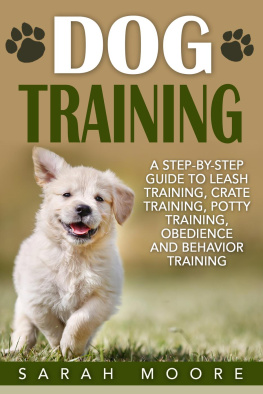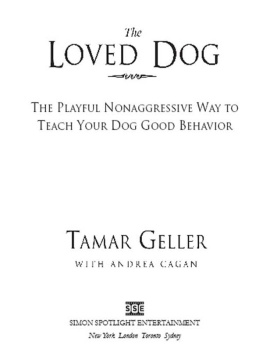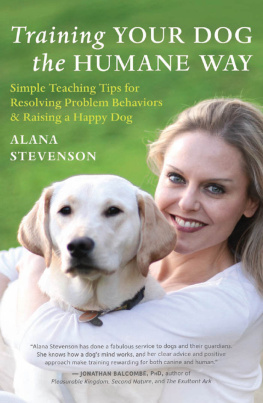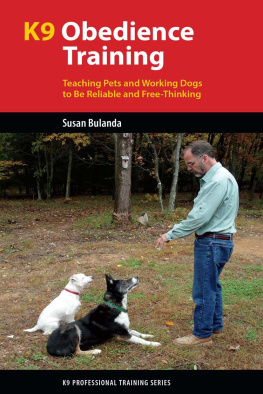Praise for Paul Loebs Revolutionary Training Techniques and
SMARTER THAN YOU THINK
[Loebs] emphasis on achieving absolute clarity in master-to-dog communication sets him apart.... His humor, passion and experienceforty years of animal trainingcome across as if the book were a seminar.
Press-Telegram (Long Beach, CA)
A witty, sensitive and practical approach to matters involving living with pups and dogs.... Loeb gives quick, practical, easily understood and responsible dog-ownership and training methods to prevent objectionable behavior. There are some interesting diet proposals and practical housebreaking tips as well.
The Pilot (Southern Pines, NC)
SMARTER THAN YOU THINK is intriguing... worth a try.
Grand Rapids Press (MI)
Presents excellent training techniques.
Library Journal
As featured on Leeza
Previous Works by Paul Loeb
Paul Loebs Complete Book of Dog Training
You Can Train Your Cat
Supertraining Your Dog
Cathletics
Nutrition and Your Dog
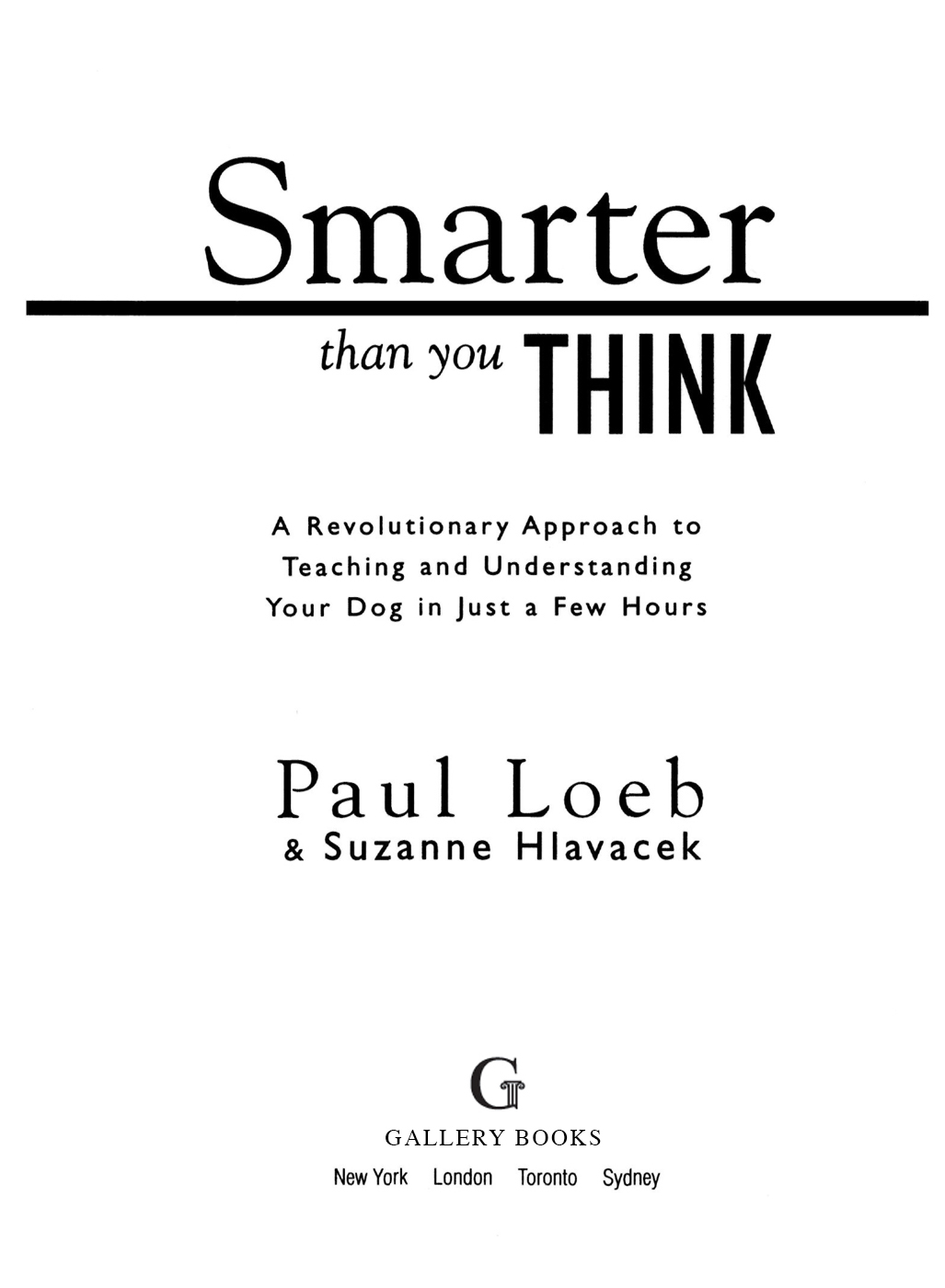
Heres to all the dogs in the world. And a special thanks to our dogs, Willy and Tibby, who are here now, and to the memory of Plum, Inches, Sleepy Joe, and Snapper Danfor letting us get to know them and love them.
For ease of writing we have referred to all the dogs in this book using the impersonal pronoun he . This in no way implies favoritism. We love all dogs equally.
Originally published in hardcover in 1997 by Pocket Books

GALLERY BOOKS, a division of Simon & Schuster Inc.
1230 Avenue of the Americas, New York, NY 10020
www.SimonandSchuster.com
Copyright 1997 by Paul Loeb and Suzanne Hlavacek
All rights reserved, including the right to reproduce this book or portions thereof in any form whatsoever. For information address Gallery Books, 1230 Avenue of the Americas, New York, NY 10020
ISBN: 0-671-02328-4
ISBN-13: 978-1-4391-3902-8 (eBook)
First Pocket Books trade paperback printing August 1998
GALLERY and colophon are registered trademarks of Simon & Schuster Inc.
Jacket photographs by Robert Sebree
Cover design by Joseph Perez
Front cover photos: top, Ann Shamel/Graphistock/PNI; bottom left, Henry Ausloos/Animals Animals; bottom right, Barbara Reed/Animals Animals; back cover photo by William Silliker, Jr./Animals Animals
CONTENTS
INTRODUCTION
One day youve got your life well in order, and things are running smoothly. The next day, chaos. Your house has been destroyed, your patience exhausted, and you feel like your well-ordered life is in shambles. What natural disaster struck, spinning you out of control? Youve got a new dog!
Is your house all chewed up? And as time goes by do you believe this is because your dog is still teething? After all these years? What about housebreaking? Is that ever going to be over with? Perhaps you suspect your dog has a learning disability or that he suffers from an acute separation anxiety complex. Maybe you think he is handicapped with all of the above.
No matter what your findings and conclusions are, you still must find the answers to survive, to combat this home wrecker and put your house and mind back together.
You buy fifty different dog books, determined to solve all your problems. You go to a dog training school; your dog learns to sit. Youre told if you dont practice sit diligently for five, six, or even eight hours a day, your dog will forget to sit. So you try. But you cant. You do need some time for yourself. You have to go to work, thats eight hours. You have to sleep, thats eight hours. You have to eat, thats three hours. You might want to shower and dress. When you get home from work you might want to change your clothes, which takes time. Read a newspaper, more time. Be with your family and friends and maybe get a night out to go to the movies. More time. There just isnt enough time in a day for you to practice your doggy lessons. So ultimately youre doomed to fail. Unless, of course, you quit your job, dont eat, dont sleep, dont read, dont shower or relax, and dont go to the movies. Just practice, practice, practice, sit, stay, heel, and no, all day...
In spite of your best efforts, the books you read, and the classes you took your dog to, you both failed. It didnt work. So now you bring an expert into your home. He looks at your dog, shakes his head, and blames all your dogs problems on you. You now have guilt. He shows you how he makes your dog sit. At this point, you dont care if your dog ever sits again. You now feel inadequate and defeated. Then the expert puts your dog in a cage and leaves. Oh, yes, he charges you lots of $$$$$$.
Im sure you have heard all kinds of excuses and solutions from professionals and professionals and professionals, including psychics, soothsayers, and your neighbors. It seems everyone is an expert. So how come with all this intelligence, both solicited and unsolicited, nothing works? Oh, yes, your dog does sit for you, when he feels like it.
You can have a well-behaved, responsible dog in no time at all, and without endless and overbearing practice sessions . Its not magic and its not mysterious. Quite simply, you are going to be learning a new and better way to communicate with your dog. In fact, we will take the confusion and myths out of understanding and educating your dog altogether and redefine those terms.
When I work with a new dog or puppy and his owner, it takes no more than three hours to fully teach both of them everything necessary for a successful relationship. Im not saying that you could or couldnt learn in three hours; what I am saying is that if you read this book from cover to cover, you will have all the information you need to accomplish this. This book is a successful three-hour seminar, with real solutions to real problems.
When I started out over forty years ago, there wasnt much information available on dog training. In the area of animal behavior there was information, but there was no way to practically apply this information to our dogs. For dogs, what information there was consisted of simple one-word commands, (sit, stay, no, heel, come) with a lot of practice. I was led to believe that dogs were not capable of understanding anything more sophisticated or complex. Not enough emphasis was placed on their intelligence. And if one starts with the premise that dogs are stupid and are very limited in their understanding, then one is stuck with old, limited dog-training methods and techniques.
I laugh now when I see how in my first book (written in 1975), I cautioned owners about first mastering no before going on to other commands like sit and stay, and that repetition was very important. As for diet and nutrition, I relied on experts, like dog-food companies. It was rather like me relying on a giant commercial food company for all the information I would ever need for all my nutritional needs. I didnt question their nutritional claims, nor did I fully understand to what degree diet was important in training and behavior.
In my first books and even today, the human element is still what fascinates me. The human-animal interaction. No dog responds in quite the same way as another. And differences and idiosyncrasies can be found in the behavior patterns of their owners. So both the owner and the dog are my students. But still its the dogs owner who must learn to train his own dog in his own way. Thats what I taught then and thats what I teach now. This I call transferencemaking sure that the dog recognizes his owner as the authority figure, or pack leader. What good is it for me to teach the dog my way, and to listen to me, when the dog isnt mine and doesnt live with me?
Next page



